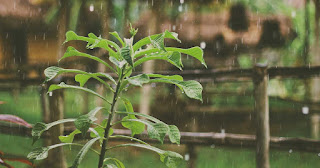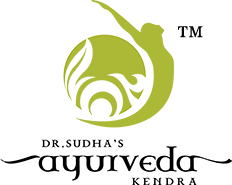
Monsoon Care In Ayurveda
 The year, according to Ayurveda is divided into two periods depending on the direction of movement of Sun ie. Uttarayana ( adanakala) and Dakshinayana (visargakala) each consist of 3 seasons. Sisira (winter) vasanta (spring) and Grishma (summer) in uttarayana and Varsha(monsoon) sarat and hamanta (late autumn) in dakshinayana.
The year, according to Ayurveda is divided into two periods depending on the direction of movement of Sun ie. Uttarayana ( adanakala) and Dakshinayana (visargakala) each consist of 3 seasons. Sisira (winter) vasanta (spring) and Grishma (summer) in uttarayana and Varsha(monsoon) sarat and hamanta (late autumn) in dakshinayana.Uttarayana indicates the ascent of the sun in northward direction, during this period sun and wind are very powerful. The sun takes away the strength of the people and cooling quality of earth. This period in India can be compared to mid January to mid -July until the monsoon starts. Monsoon is the begin of Dakshinayana where the movement of the sun is in the downward direction. During this period the moon is more powerful than the sun and the wind is not very dry.
The earth becomes cool due to the clouds, rains and cold winds. Strength of the creatures enhances during this period. Human beings experience debility in the beginning and maximum strength in the end of visargakala . But as we said before, Varsha ritu (monsoon) is the starting of the visargakala after the summer, that comes in Adanakala, there will be certain derangement in the doshas in the human body. Due to the sudden change in the climate, the body of the humans will be very tender due to which there will be chance of getting diseases easily, so special care to be taken during this period following strict regiments.
This time is characterized by doshic imbalances and low immunity. Special monsoon diet and other therapies are recommended to ward off the imbalances in the body and boost immunity.
During summer, there will be displacement of the vata dosha that vata dosha becomes deranged and vitiated during monsoons. In monsoon there will be pitta dosha displacement. Both vata and pitta together causes various diseases. Vitiated pitta dosha causes imbalances in the agni causing trouble in the digestion. So special care to be taken in the diet so that it will not hamper the agni.
Due to weak immunity, monsoon calls for proper care to prevent diseases.
Panchakarma treatments are highly recommended to clear the accumulated toxins from the body and rejuvenate the body. The deranged doshas accumulate the different parts of the body and start causing troubles.
The procedures like Abhyangam, Pizhichill etc helps to liquify the doshas which is accumulated in the body. By doing swedana or sudation the liquefied doshas are brought to the koshta or alimentary tract .Next is the Panchkarma procedures which eliminates the doshas as emesis, purgation or enema.
In addition to this, this humidity in the atmosphere often aggravates several conditions including arthritis, allergies, asthma etc. When treatment is done during this season these diseases are well managed and the effect will last upto the one year. We also advice special diet that should be followed during the monsoon.
The complete process of Panchakarma consists of three steps.
Poorva Karma, which is the preparatory procedure required before the main procedure to enable a person to receive the full benefits of the main treatment. It consists of two main processes – Snehan (oleation) and Swedan (fomentation). These methods help to dislodge the accumulated poisonous substances in the body, thus preparing them for their complete removal.
Snehana or oleation can be done both internally and externally. Administering snehana internally is by giving snehapana or giving medicated ghee internally to drink. External oleation is through procedures like Abhyanga, Pizhichil etc.
Pizhichil– This is a typical kerala treatment where two litres of warm oil is squeezed over the patients body from a piece of cloth by one hand while massaging with the other two masseur will be positioned on either side of the patient for massaging and one person will be continuously heating the oil. The massage is done in different positions such as sitting posture, lying side ways, supine posture and prone posture. The medicated oil used will be different for different people according to the prakriti, dosha, predominance and characteristics of the illness.
Swedana or fomentation is carried out by procedures like potali treatments i.e pathra pinda sweda (potali made with medicinal herbs), choorna pinda sweda (potali made with medicated powders), shashtikapinda sweda (potali made with shashtika rice).
Navarakizhi– This is a unique treatment procedures followed in kerala. Its also called shashtika pinda sweda. As the name suggest the fomentation using the bolus prepared out of shashtika shali rice. Shashtika or Navara rice is a particular kind of rice which has high nutritional value when taken internally or applied externally. This rice is cooked in milk and a decoction made of bala (sida cordifolia ) and tied to a potali (Kizhi) by dividing into 4 different boluses. Three persons will be doing the treatment; two will be massaging the patient with the potali by dipping it in the warm medicated milk. The other person will be heating the medicated milk and supplying to the two masseurs. After the specified duration of the treatment the paste is wiped off and medicated oil is applied all over the body before bath. Navarakizhi is mainly indicated for muscle wasting, emaciation, general weakness to improve skin texture and muscle tone etc. especially in polio.
Sirodhara– If you are a person who lacks sleep at night, has stress at work and home, sits continuously for too long in front of computers, has late night works, has got migraine or other headaches then you must undergo this treatment. Sirodhara helps to relax the brain and cranial nerves and improve the functioning of the nervous system. During the treatment the patient has to lie down on the droni and the medicated oil will be dripping continuously in the forehead and continuously two people will be massaging the body Which will be providing a complete relaxation to the body and mind.
Pradhan Karma or the main procedure. On completion of the first step, it is decided which of the Panchakarma procedures has to be done to the patient. This is purely determined by the dosha predominant in the patient’s body and the kinds of diseases he is suffering with. For kapha predominant diseases Vamana should be done, for pitta, virechana and for vata, vasthi should be carried out.
The panchakarma procedures
1. Vamanam (therapeutic emesis) – To eliminate the Kapha dosha in the body. Snehapana (internal oliation) in the form of ghrita is given to the patient which is to be taken in a minimum dosage initially and then as the days progress the dosage to be increased according to the digesting capacity of the patient. When the patient is saturated with ghee consumption , medicine to be given to initiate the emesis (vamana). The patient is made to vomit until the yellow bile is seen which is the completion of the treatment procedure.
2. Virechanam (purgation) – After snehapana, purgative drug must be given which will eliminate the toxins through the bowel evaluations.
3. Anuvasana (enema using medicated oil) – this enema is given in a less dosage for about 60ml to 100ml. this medicated oil will lubricate the intestine and pelvic organs, strengthens, and normalize its funtions. The medicated oil is chosen according to the condition of the patient and his disease.
4. Nasyam – nasal instillation of medicated substances helps clear the respiratory tract and para-nasal sinuses. oil instillation through the nose is the perfect way to take out the toxins which are accumulated in your head. There are different types of nasyam according to the benefit. After applying suitable oil all over head, face, neck and shoulders, good massage is given to the patient after that patient is exposed to steam. By doing this all the toxins in the head get liquified and is ready to be eliminated. When nasya is given through the nose; the oil will go through the minute channels in the head taking out the toxins and expelling it through mouth. This treatment is very good in all kinds of migranes, cervical spondylosis, sinusitis etc
5. Astapana Vasti (Therapeutic Decoction Enema) – After undergoing snehana and swedana , medicated enema is given. This is a peculiar treatment for eliminating toxin from the body. There are different type of vasti according to the benefit which will nourish the pelvic organs, good for all bones and muscles, relieves all aches and pain and eliminate the toxins from the body, improves nerve funtions etc

Thank you for sharing such a comprehensive and informative article on Ayurvedic monsoon care! I truly appreciate the detailed explanation of how the changing seasons, particularly Varsha Ritu, affect the doshas and immunity. The insights on Panchakarma treatments like Abhyangam, Pizhichil, and Sirodhara were particularly fascinating, especially how they help detoxify and rejuvenate the body during this sensitive time. Your advice on a monsoon-specific diet and therapies is invaluable for maintaining balance and health. Thanks again for such a well-researched and helpful post!